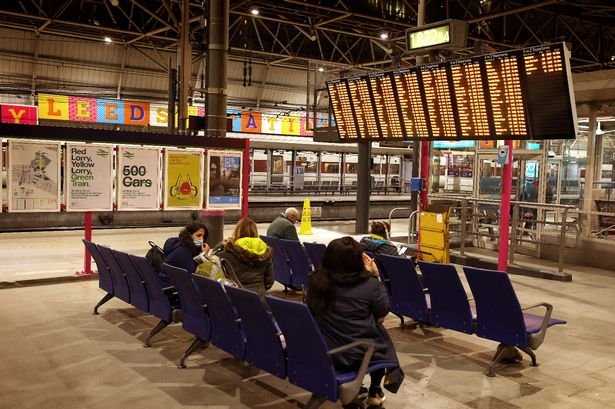
Image credit by mirror.co.uk
Leeds Train Station trains cancelled became the harsh reality for thousands of passengers on Saturday 26 July as a critical signalling system fault forced the complete closure of Yorkshire’s busiest railway hub. The unprecedented disruption left countless travellers stranded and highlighted the vulnerability of Britain’s rail infrastructure when technology fails. As Leeds Train Station trains cancelled notices spread across departure boards, the incident served as a stark reminder of how quickly modern life can grind to a halt during major transport failures.
Complete Closure Triggers Travel Nightmare
Leeds train station trains cancelled became the reality for countless passengers when Network Rail confirmed that all services to, from, and through the Yorkshire hub had been suspended. The fault with the signalling system occurred around 16:00 BST on Saturday, effectively blocking all railway lines in the Leeds area and forcing the complete closure of one of Britain’s busiest stations.
The disruption immediately affected four major train operators: Northern Rail, LNER, CrossCountry, and TransPennine Express. National Rail issued an urgent “do not travel” warning, started or ended at Leeds unless absolutely necessary.
Britain’s Railway Powerhouse Left Paralysed
The timing of the closure could not have been worse for a station that handles extraordinary passenger volumes. Leeds railway station is the second-busiest station in the United Kingdom outside London, after Birmingham New Street, and the busiest in Northern England. With 24 million passenger entries and exits between April 2022 and March 2023, the station serves as a critical transport hub connecting Yorkshire to destinations across Britain.
The station’s importance extends far beyond local travel. As the terminus of the Leeds branch of the East Coast Main Line, it provides half-hourly high-speed services to London King’s Cross via LNER. The facility also serves as a major stop on the Cross Country Route, linking Scotland, the Midlands, and South West England, while connecting passengers to cities including Glasgow, Edinburgh, Manchester, Liverpool, and Newcastle.
Cascading Effects Across the Network
The signalling fault created a domino effect throughout the rail network. Trains were either cancelled outright, delayed by up to 120 minutes, or diverted via alternative routes such as Doncaster. The disruption was so severe that many services could not call at Leeds or Wakefield Westgate, forcing passengers to seek alternative arrangements.
TransPennine Express warned customers of “major disruption” and advised against travelling north of Manchester, citing severe overcrowding and heavy delays for services passing through Leeds. Similarly, LNER implemented rail replacement buses between Leeds and Doncaster, while arranging services between Bradford Forster Square, Harrogate, York, and Leeds.
The compensation arrangements highlighted the scale of the problem. Train operators allowed passengers to use their tickets on rival services at no extra cost, with CrossCountry, LNER, Northern, and TransPennine Express all accepting each other’s tickets during the crisis. For those unable to travel on Saturday, major operators validated tickets for use the following day.
The Vulnerability of Modern Railways
The Leeds incident exposes the critical dependence of Britain’s railway system on sophisticated signalling technology. Network Rail operates approximately 40,000 signals across the network, with signalling systems designed to automatically turn red and stop trains when problems are detected. This fail-safe approach prioritises safety but can result in widespread disruption when faults occur.
The signalling challenge facing Britain is immense. Network Rail faces a £4 billion, 10-year programme to modernise the country’s signalling infrastructure, with £3 billion allocated specifically for digital signalling technology. The current approach involves gradually introducing European Train Control System (ETCS) technology, which replaces traditional lineside signals with digital displays in train drivers’ cabs.
However, digitalising Britain’s vast 20,000-mile railway network represents a complex undertaking that must be completed in phases. The East Coast Digital Programme, a £1.4 billion initiative, aims to introduce digital signalling between London King’s Cross and Grantham, with the first trains expected to operate using this technology by the end of next year.
Passenger Rights During Disruption
When Leeds train station trains cancelled scenarios occur, passengers retain specific rights under UK railway regulations. The Delay Repay scheme provides compensation for journeys delayed by 15 minutes or more, depending on the train operator. Northern Rail, one of the primary operators affected by the Leeds closure, offers compensation ranging from 25% for delays of 15-29 minutes to full refunds for delays exceeding two hours.
Passengers experiencing cancellations can claim full refunds from their original point of purchase without fees. During severe disruption, operators typically lift ticket restrictions, allowing passengers to travel on alternative services within reasonable timeframes. The compensation process requires passengers to retain their tickets and submit claims within 28 days of their journey.
Recent statistics reveal the scale of delay compensation claims across Britain’s railway network. Between April 2024 and March 2025, train operators processed 8.3 million delay compensation claims, representing a 9% increase from the previous year. Encouragingly, 81.6% of claims were approved, with 99.1% processed within the standard 20 working days.
Network Performance Under Pressure
The Leeds signalling fault occurred against a backdrop of declining railway performance across Britain. Latest quarterly figures show that train cancellations reached 3.4% between January and March 2025, an increase of 0.1 percentage points compared to the same period in 2024. The annual cancellation rate for the 12 months ending March 2025 stood at 4.1%, representing a 0.3 percentage point deterioration.
Northern Trains, which operates extensive services through Leeds, faces particular challenges with reliability. The operator was responsible for the highest proportion of its own cancellations at 62% in the latest quarter, reflecting ongoing issues with staff availability and operational resilience.
Investment in Resilience
The government recognises the urgent need for railway infrastructure investment. Recent initiatives include Project Reach, a partnership between Network Rail, Neos Networks, and Freshwave designed to eliminate mobile signal blackspots and upgrade telecommunications infrastructure along major rail routes. This £300 million private investment programme aims to enhance connectivity while supporting the adoption of new monitoring technologies.
Network Rail’s Target 190 programme specifically addresses signalling renewal costs, aiming to reduce the current ETCS Level 2 Signalling Equivalent Unit cost from £315,000 to £190,000 or lower. This initiative combines technological advances, standardisation, and automation to deliver more affordable signalling solutions.
Swift Resolution and Lessons Learned
The Leeds signalling fault was resolved by approximately 17:00 BST on Saturday, though Network Rail warned that travel disruption would continue until the end of the day. By Sunday morning, National Rail confirmed that the signalling system had been fully restored and trains could operate through the area normally.
Despite the swift technical resolution, the incident demonstrates the fragility of Britain’s transport infrastructure. A single signalling fault at one of the country’s busiest stations created travel chaos affecting thousands of passengers across multiple regions. The event underscores the critical importance of continued investment in railway signalling technology and the need for robust contingency planning.
The Leeds train station trains cancelled crisis serves as a wake-up call for Britain’s railway industry. As passenger numbers continue recovering towards pre-pandemic levels and demand for reliable public transport grows, the resilience of critical infrastructure becomes increasingly important. The incident highlights both the sophisticated safety systems that protect passengers and the potential consequences when technology fails in our interconnected transport network.
While Saturday’s disruption caused significant inconvenience, it also demonstrated the railway industry’s ability to respond quickly to emergencies, coordinate alternative arrangements, and restore normal service within hours. However, preventing such incidents through continued investment in modern, reliable signalling systems remains the ultimate goal for Britain’s railway future.
Read More: Click here




